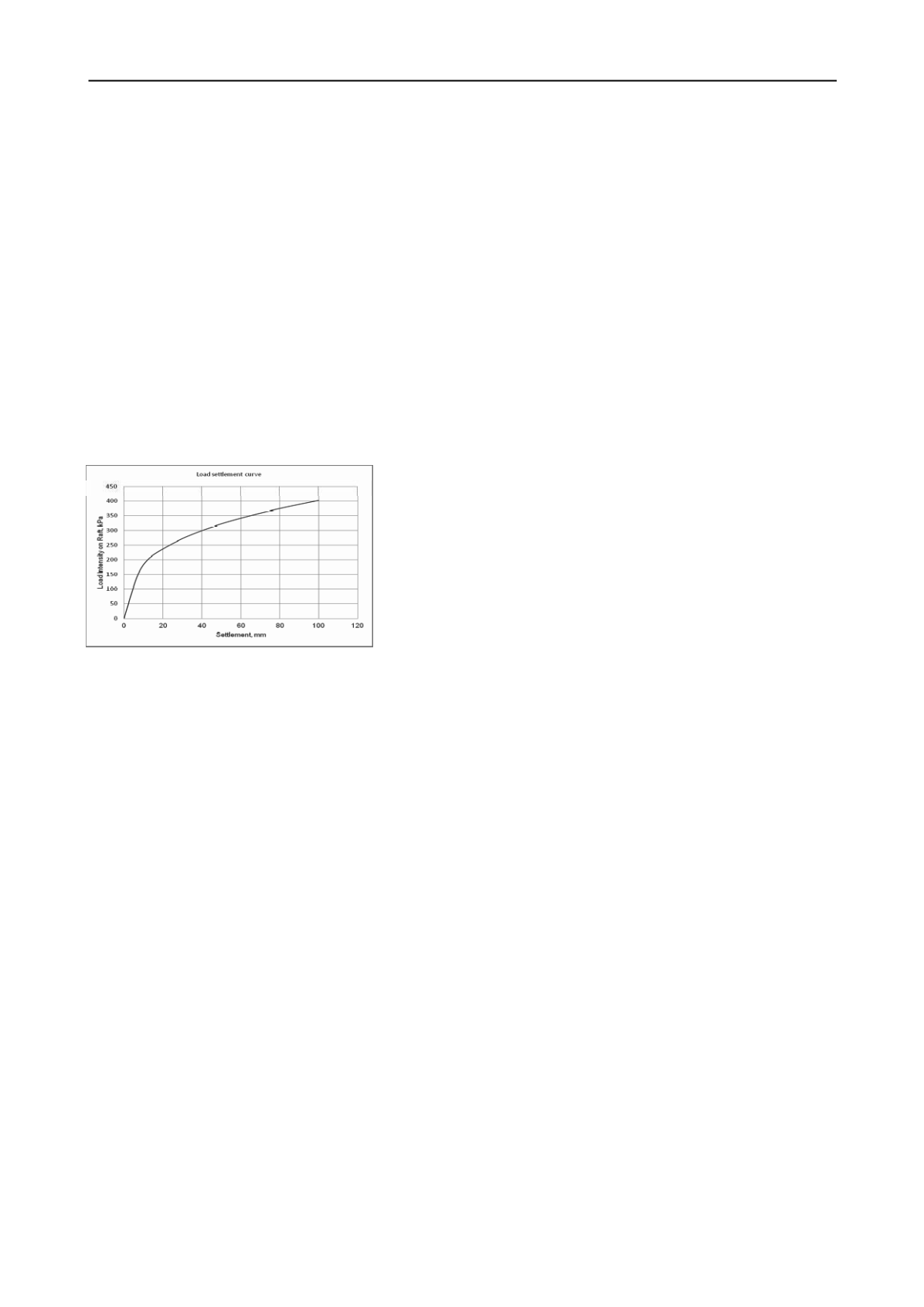
658
Proceedings of the 18
th
International Conference on Soil Mechanics and Geotechnical Engineering, Paris 2013
has exhibited a hyperbolic behaviour. It has been established
that the hyperbolic behaviour can be expressed in terms of
Chin-Kondtner type functions, when the inverse of the stiffness
is plotted against settlement, a linear plot can be obtained. In
that case the inverse of the slope gives the asymptotic ultimate
capacity of the pier. Accordingly as atypical case the load
settlement response of the piled raft with 12m pier was plotted
as Chin’s graph.
Figure 7
The asymptotic ultimate capacity was found to be of the order
of 750kN, indicating that the asymptotic ultimate capacity is
three times the capacity at the elastic limit and 1.5 times the
load corresponding to the elasto plastic stage. This would mean
that the capacity has to be limited to the load corresponding to
the elasto plastic stage. Therefore the limiting capacity of the
piled raft can be the capacity at a settlement level of 10% of the
pile diameter when the pile can be seated in the non-
compressible layer and when the pile has to pass through a
compressible layer, and then the negative friction has to be
accounted for.
8.
OBSERVATIONAL STUDY MODEL
Figure 8 presents the load settlement response of the pier
representing the pile group and the raft which forms a part of
the piled raft supporting the structure. Here it is seen that the
elastic stage is seen upto a load level of 200kN per sq.m.
However in the analyses the pressure was applied continuously
whereas during construction the load was applied in gradual
manner over a period of time.
However the settlement shown by the equivalent pier analyses
is 12 mm as against the observed value of 14mm reported in the
referred publication, The load sharing behaviour and the shaft
stress mobilisation exhibited a similar trend as in the case of
earlier model and as observed in the observational study. In this
case the load level was found to be well with in the elastic
limits. The settlement observed from the observational study
was 14mm and from the pier analyses the settlement obtained
was 12mm indicating a very close agreement indicating that the
equivalent pier concept can fill the need of a simple design
procedure.
9.
CONCLUSIONS
The extensive study carried out on the two independent cases
adopting the equivalent pier theory has established that the
equivalent pier theory,
although involves numerical
approximation, the performance of the piled raft in both the
cases predicted by equivalent pier theory is in conformity with
the earliar works by Oh etal.,(2008) and Balakumar (2008)The
study has further pointed out that in the case of piled rafts with
the pile group passing through seams of compressible layer the
behaviour is affected by the mobilisation of negative skin
friction and the equivalent pier concept is able to predict this
effectively.The compressible layer generates negative skin
friction and increases the load on the pile as shown by the
increase in the load sharing ratio and then allows the pile group
behaviour to be ductile. In short the equivalent pier theory is an
ideal theory for the piled raft analyses.
10. REFERENCES
Clancy P. (1993), Numerical Analysis of Piled Raft Foundations,
University of Western Australia, PhD Thesis.
‘Katzenbach R., Arslan V. and Moorman ch (2000a), ‘Numerical
Stimulations of Combined Piled Raft Foundations for the New
High Rise Building, Max
in Frankfurt am main’, Proc. 2nd Int.
Conf. on Soil Structure Interaction in Urban Civil Engineering.
. Poulos H.G. (2001), ‘Piled Raft Foundation: Design and
Application’, Geotechnique, Vol. 51, No. 2, pp 111
-113
Horikoshi K. (1995), ‘Optimum Design of Piled Raft Foundations’,
Dissertation submitted for the degree of Doctor of Philosophy,
University of Western Australia.
E.Y.N OH, M. Huang, C. Surarak, R.Adamec and
A.S.Balasubramaniam (2008), ‘Finite Element Modeling for Piled
Raft Foundation i
n Sand’, Eleventh East Asia –
Pacific Conference
on Structural Engineering & Construction (EASEC
–
11).
Polous H.G. (2008), “The Piled Raft Foundation for the Burj Dubai –
Design & Performance”. IGS –
Ferroco Terzaghi, Oration
–
2008.
Balakumar.V (2008),
“Experimental Studies of Model Piled Raft on
Sand and Field Study of Prototype Behavior”. PhD. Thesis, Anna
University, Chennai.
Burland J.B. (1995), ‘Piles as Settlement Reducer’ 18th Italian Congress
on Soil Mech., Pavia.
Russo G. (1998), ‘Numerical Analyses of Piled Rafts’, Intl. Jnl. Num.
and Anl. Methods in Geomech, Vol. 22, pp. 477-493.
Small J and Poulos, H.G. (2007) “A Method of Analysis of Piled Raft”,
10th Australia Newzeland Conference on Geo Mechanics, PP. 555.
Yamashita.K , Hamada.J, Yamada.T. (2010), Field Measurements On
Piled Rafts with Grid-Form Deep Mixing Walls on Soft Ground,
Geaotechnical Engineering-SEAGS Vol.42 No 2 June 2011
Figure 8 Load settlement response pier


